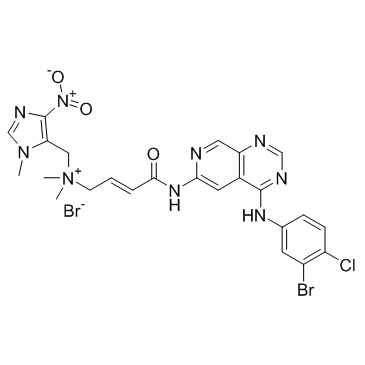1636180-98-7
| Name | tarloxotinib bromide |
|---|---|
| Synonyms |
1H-Imidazole-5-methanaminium, N-[(2E)-4-[[4-[(3-bromo-4-chlorophenyl)amino]pyrido[3,4-d]pyrimidin-6-yl]amino]-4-oxo-2-buten-1-yl]-N,N,1-trimethyl-4-nitro-, bromide (1:1)
tarloxotinib bromide 3Y31FJ8K50 (2E)-4-({4-[(3-Bromo-4-chlorophenyl)amino]pyrido[3,4-d]pyrimidin-6-yl}amino)-N,N-dimethyl-N-[(1-methyl-4-nitro-1H-imidazol-5-yl)methyl]-4-oxo-2-buten-1-aminium bromide |
| Description | Tarloxotinib bromide is an irreversible EGFR/HER2 inhibitor. |
|---|---|
| Related Catalog | |
| Target |
EGFR/HER2 |
| In Vitro | To confirm the mechanism of action, Tarloxotinib bromide is shown to be metabolized efficiently under hypoxia using a panel of human NSCLC cell lines (rate of TKI release 0.4-2.1 nM/hr/106 cells), a process that is inhibited by oxygen (TKI release <0.002 nM/hr/106 cells). Cellular anti-proliferative and receptor phosphorylation assays demonstrate a 14-80 fold reduction of Tarloxotinib bromide activity relative to TKI. Using PC9 tumors, hyperbaric oxygen breathing suppresse release of TKI from Tarloxotinib bromide by >80% (538 vs 99 nM/kg; p<0.01) compared to air breathing controls. Collectively, these data further validate that Tarloxotinib bromide is a hypoxia-activated irreversible EGFR-TKI, and show that Tarloxotinib bromide has greater activity compared with erlotinib[2]. |
| In Vivo | A prototypic WT EGFR driven xenograft model (A431) is used to benchmark Tarloxotinib bromide activity against each EGFR-TKI by ‘retrotranslation’ of reported plasma exposure for each agent in human subjects back to the xenograft model. Only treatment with clinically relevant doses and schedules of Tarloxotinib bromide is associated with tumor regression and durable inhibition of WT EGFR tumor phosphorylation. Consistent with these findings, Tarloxotinib bromide treatment can also regress the WT EGFR NSCLC tumor models H125 and H1648, demonstrating Tarloxotinib bromide provides the necessary therapeutic index to inhibit WT EGFR in vivo[1]. |
| References |
| Molecular Formula | C24H24Br2ClN9O3 |
|---|---|
| Molecular Weight | 681.767 |
| Exact Mass | 679.005737 |
| Storage condition | 2-8℃ |
